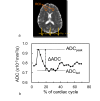Hemodynamically self-corrected ΔADC analysis in idiopathic normal pressure hydrocephalus
- PMID: 30760003
- PMCID: PMC6580904
- DOI: 10.1259/bjr.20180553
Hemodynamically self-corrected ΔADC analysis in idiopathic normal pressure hydrocephalus
Abstract
Objective: To clarify the cause of higher water fluctuation of the brain in idiopathic normal pressure hydrocephalus (iNPH), we assessed change in hemodynamic-independent apparent diffusion coefficient during the cardiac cycle (ΔADC) in iNPH.
Methods: Electrocardiographically synchronized single-shot diffusion echo-planer imaging (b = 0, 500, and 1000 s/mm2) was performed in healthy volunteers, atrophic ventricular dilation group, and iNPH group, respectively. The ΔADC (b = 0 and 1000 s/mm2) and maximum ADC (b = 0 and 500 s/mm2) in the cardiac cycles were measured at the frontal white matter in the brain. Then, self-corrected ΔADC was obtained from the ΔADC divided by the maximum ADC (ADCpeak: perfusion-related diffusion) to correct the blood flow effect.
Results: The ΔADC after correction was significantly higher in the iNPH group than in the other two groups. However, there was no significant difference in ADCpeak values among the groups.
Conclusion: Self-corrected ΔADC in iNPH increased because of changes in the biomechanical properties of the brain. Self-corrected ΔADC analysis makes it possible to obtain information on hemodynamically independent water fluctuation as well as perfusion in iNPH.
Advances in knowledge: Analysis self-corrected ΔADC provides simultaneously information on biomechanical properties, perfusion, and water fluctuation in iNPH.
Conflict of interest statement
Figures





Similar articles
-
Changes in Apparent Diffusion Coefficient (ADC) during Cardiac Cycle of the Brain in Idiopathic Normal Pressure Hydrocephalus Before and After Cerebrospinal Fluid Drainage.J Magn Reson Imaging. 2021 Apr;53(4):1200-1207. doi: 10.1002/jmri.27412. Epub 2020 Oct 28. J Magn Reson Imaging. 2021. PMID: 33112007
-
Idiopathic normal-pressure hydrocephalus: temporal changes in ADC during cardiac cycle.Radiology. 2011 Nov;261(2):560-5. doi: 10.1148/radiol.11101860. Epub 2011 Sep 7. Radiology. 2011. PMID: 21900622
-
Delta-ADC (apparent diffusion coefficient) analysis in patients with idiopathic normal pressure hydrocephalus.Acta Neurochir Suppl. 2012;114:197-200. doi: 10.1007/978-3-7091-0956-4_38. Acta Neurochir Suppl. 2012. PMID: 22327692
-
The role of diffusion tensor imaging and fractional anisotropy in the evaluation of patients with idiopathic normal pressure hydrocephalus: a literature review.Neurosurg Focus. 2016 Sep;41(3):E12. doi: 10.3171/2016.6.FOCUS16192. Neurosurg Focus. 2016. PMID: 27581308 Review.
-
Neural circuits of idiopathic Normal Pressure Hydrocephalus: A perspective review of brain connectivity and symptoms meta-analysis.Neurosci Biobehav Rev. 2020 May;112:452-471. doi: 10.1016/j.neubiorev.2020.02.023. Epub 2020 Feb 20. Neurosci Biobehav Rev. 2020. PMID: 32088348 Review.
Cited by
-
Effect of Body Position on Dynamic Apparent Diffusion Coefficient Changes During the Cardiac Cycle in the Human Brain.J Magn Reson Imaging. 2025 Jul;62(1):295-302. doi: 10.1002/jmri.29758. Epub 2025 Mar 21. J Magn Reson Imaging. 2025. PMID: 40114592 Free PMC article.
-
Diffusion Tensor Imaging Profiles Can Distinguish Diffusivity and Neural Properties of White Matter Injury in Hydrocephalus vs. Non-hydrocephalus Using a Strategy of a Periodic Table of DTI Elements.Front Neurol. 2022 Jul 6;13:868026. doi: 10.3389/fneur.2022.868026. eCollection 2022. Front Neurol. 2022. PMID: 35873785 Free PMC article.
-
Fast Phase-Contrast Cine MRI for Assessing Intracranial Hemodynamics and Cerebrospinal Fluid Dynamics.Diagnostics (Basel). 2020 Apr 21;10(4):241. doi: 10.3390/diagnostics10040241. Diagnostics (Basel). 2020. PMID: 32326291 Free PMC article.
References
-
- Marmarou A , Bergsneider M , Klinge P , Relkin N , Black PM . The value of supplemental prognostic tests for the preoperative assessment of idiopathic normal-pressure hydrocephalus . Neurosurgery 2005. ; 57 ( suppl_3 ): S2-17 – S2-28 discussion ii–v. . doi: 10.1227/01.NEU.0000168184.01002.60 - DOI - PubMed

